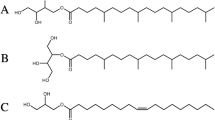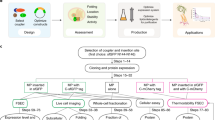Abstract
A detailed protocol for crystallizing membrane proteins that makes use of lipidic mesophases is described. This has variously been referred to as the lipid cubic phase or in meso method. The method has been shown to be quite general in that it has been used to solve X-ray crystallographic structures of prokaryotic and eukaryotic proteins, proteins that are monomeric, homo- and hetero-multimeric, chromophore-containing and chromophore-free, and α-helical and β-barrel proteins. Its most recent successes are the human-engineered β2-adrenergic and adenosine A2A G protein–coupled receptors. Protocols are provided for preparing and characterizing the lipidic mesophase, for reconstituting the protein into the monoolein-based mesophase, for functional assay of the protein in the mesophase and for setting up crystallizations in manual mode. Methods for harvesting microcrystals are also described. The time required to prepare the protein-loaded mesophase and to set up a crystallization plate manually is about 1 h.
This is a preview of subscription content, access via your institution
Access options
Subscribe to this journal
Receive 12 print issues and online access
$259.00 per year
only $21.58 per issue
Buy this article
- Purchase on Springer Link
- Instant access to full article PDF
Prices may be subject to local taxes which are calculated during checkout




















Similar content being viewed by others
References
Laver, W.G., Bischofberger, N. & Webster, R.G. Disarming flu viruses. Sci. Am. 280, 78–87 (1999).
Renfrey, S. & Featherstone, J. Structural proteomics. Nat. Rev. Drug Discov. 1, 175–176 (2002).
Caffrey, M. Membrane protein crystallization. J. Struct. Biol. 142, 108–132 (2003).
Wiener, M.C. A pedestrian guide to membrane protein crystallization. Methods 34, 364–372 (2004).
Sutton, B.J. & Sohi, M.K. Crystallization of membrane proteins for X-ray analysis. Methods Mol. Biol. 27, 1–18 (1994).
Fromme, P Crystallization of Photosystem I. In Methods and Results in Crystallization of Membrane Proteins (ed. Iwata, S.) 145–174 (International University Line, San Diego, 2003).
Ng, J.D., Stevens, R.C. & Kuhn, P. Protein crystallization in restricted geometry: advancing old ideas for modern times in structural proteomics. Methods Mol. Biol. 426, 363–376 (2008).
Ng, J.D., Gavira, J.A. & Garcia-Ruiz, J.M. Protein crystallization by capillary counterdiffusion for applied crystallographic structure determination. J. Struct. Biol. 142, 218–231 (2003).
Loll, P.J., Tretiakova, A. & Soderblom, E. Compatibility of detergents with the microbatch-under-oil crystallization method. Acta Crystallogr. D Biol. Crystallogr. 59, 1114–1116 (2003).
Chayen, N.E. Crystallization of Membrane Proteins in Oils. In Methods and Results in Crystallization of Membrane Proteins (ed. Iwata, S.) 131–140 (International University Line, San Diego, 2003).
Raman, P., Cherezov, V. & Caffrey, M. The Membrane Protein Data Bank. Cell. Mol. Life Sci. 63, 36–51 (2006).
Faham, S. & Bowie, J.U. Bicelle crystallization: a new method for crystallizing membrane proteins yields a monomeric bacteriorhodopsin structure. J. Mol. Biol. 316, 1–6 (2002).
Takeda, K. et al. A novel three-dimensional crystal of bacteriorhodopsin obtained by successive fusion of the vesicular assemblies. J. Mol. Biol. 283, 463–474 (1998).
Qiu, H. & Caffrey, M. The phase diagram of the monoolein/water system: metastability and equilibrium aspects. Biomaterials 21, 223–234 (2000).
Luzzati, V. X-ray diffraction studies of lipid-water systems. In Biological Membranes, Physical Fact and Function Vol. 1, (ed. Chapman, D.) 71–123 (Academic Press, London, 1968).
Shipley, G.G., Green, J.P. & Nichols, B.W. The phase behavior of monogalactosyl, digalactosyl, and sulphoquinovosyl diglycerides. Biochim. Biophys. Acta 311, 531–544 (1973).
Wisniewski, J.R. Protocol to enrich and analyze plasma membrane proteins from frozen tissues. Methods Mol. Biol. 432, 175–183 (2008).
Yip, T.T. & Hutchens, T.W. Immobilized metal-ion affinity chromatography. Methods Mol. Biol. 244, 179–190 (2004).
Selkirk, C. Ion-exchange chromatography. Methods Mol. Biol. 244, 125–131 (2004).
Cutler, P. Size-exclusion chromatography. Methods Mol. Biol. 244, 239–252 (2004).
Landau, E.M. & Rosenbusch, J.P. Lipidic cubic phases: a novel concept for the crystallization of membrane proteins. Proc. Natl. Acad. Sci. USA 93, 14532–14535 (1996).
Cherezov, V., Clogston, J., Papiz, M.Z. & Caffrey, M. Room to move: crystallizing membrane proteins in swollen lipidic mesophases. J. Mol. Biol. 357, 1605–1618 (2006).
Cherezov, V. et al. In meso structure of the cobalamin transporter, BtuB, at 1.95 Å resolution. J. Mol. Biol. 364, 716–734 (2006).
Cherezov, V. et al. In meso crystal structure and docking simulations suggest an alternative proteoglycan binding site in the OpcA outer membrane adhesin. Proteins 71, 24–34 (2008).
Cherezov, V. et al. High-resolution crystal structure of an engineered human beta2-adrenergic G protein-coupled receptor. Science 318, 1258–1265 (2007).
Jaakola, V.P. et al. The 2.6 angstrom crystal structure of a human A2A adenosine receptor bound to an antagonist. Science 322, 1211–1217 (2008).
Cherezov, V. & Caffrey, M. Nano-volume plates with excellent optical properties for fast, inexpensive crystallization screening of membrane proteins. J. Appl. Cryst. 36, 1372–1377 (2003).
Cherezov, V., Peddi, A., Muthusubramaniam, L., Zheng, Y.F. & Caffrey, M. A robotic system for crystallizing membrane and soluble proteins in lipidic mesophases. Acta Crystallogr. D Biol. Crystallogr. 60, 1795–1807 (2004).
Cherezov, V. & Caffrey, M. Picolitre-scale crystallization of membrane proteins. J. Appl. Cryst. 39, 604–606 (2006).
Cherezov, V. & Caffrey, M. A simple and inexpensive nanoliter-volume dispenser for highly viscous materials used in membrane protein crystallization. J. Appl. Cryst. 38, 398–400 (2005).
Ai, X. & Caffrey, M. Membrane protein crystallization in lipidic mesophases: detergent effect. Biophys. J. 79, 394–405 (2000).
Misquitta, Y. & Caffrey, M. Detergents destabilize the cubic phase of monoolein: implications for membrane protein crystallization. Biophys. J. 85, 3084–3096 (2003).
Cheng, A., Hummel, B., Qiu, H. & Caffrey, M. A simple mechanical mixer for small viscous lipid-containing samples. Chem. Phys. Lipids 95, 11–21 (1998).
Lide, D.R. (ed.). CRC Handbook of Chemistry and Physics 89th edn. (CRC Press, Boca Raton, FL, 2008).
Misquitta, Y. et al. Rational design of lipid for membrane protein crystallization. J. Struct. Biol. 148, 169–175 (2004).
Lunde, C.S. et al. UV microscopy at 280 nm is effective in screening for the growth of protein microcrystals. J. Appl. Cryst. 38, 1031–1034 (2005).
Ng, J.D. et al. The crystallization of biological macromolecules from precipitates: evidence for Ostwald ripening. J. Cryst. Growth 168, 50–62 (1996).
Benvenuti, M. & Mangani, S. Crystallization of soluble proteins in vapor diffusion for x-ray crystallography. Nat. Protoc. 2, 1633–1651 (2007).
Nollert, P. & Landau, E.M. Enzymic release of crystals from lipidic cubic phases. Biochem. Soc. Trans. 26, 709–713 (1998).
Luecke, H., Schobert, B., Richter, H.T., Cartailler, J.P. & Lanyi, J.K. Structure of bacteriorhodopsin at 1.55 Å resolution. J. Mol. Biol. 291, 899–911 (1999).
Pflugrath, J.W. Macromolecular cryocrystallography—methods for cooling and mounting protein crystals at cryogenic temperatures. Methods 34, 415–423 (2004).
Liu, W. & Caffrey, M. Gramicidin structure and disposition in highly curved membranes. J. Struct. Biol. 150, 23–40 (2005).
Taylor, R., Burgner, J.W., Clifton, J. & Cramer, W.A. Purification and characterization of monomeric Escherichia coli vitamin B12 receptor with high affinity for colicin E3. J. Biol. Chem. 273, 31113–31118 (1998).
Papiz, M.Z. et al. Crystallization and characterization of two crystal forms of the B800-850 light-harvesting complex from Rhodopseudomonas acidophila strain 10050. J. Mol. Biol. 209, 833–835 (1989).
Prince, S.M. et al. Expression, refolding and crystallization of the OpcA invasin from Neisseria meningitidis . Acta Crystallogr. D Biol. Crystallogr. 57, 1164–1166 (2001).
Rosenbaum, D.M. et al. GPCR engineering yields high-resolution structural insights into beta2-adrenergic receptor function. Science 318, 1266–1273 (2007).
Cherezov, V. & Caffrey, M. Membrane protein crystallization in lipidic mesophases. A mechanism study using X-ray microdiffraction. Faraday Discuss. 136, 195–212 (2007).
Cherezov, V., Fersi, H. & Caffrey, M. Crystallization screens: compatibility with the lipidic cubic phase for in meso crystallization of membrane proteins. Biophys. J. 81, 225–242 (2001).
Caffrey, M. Kinetics and mechanism of transitions involving the lamellar, cubic, inverted hexagonal, and fluid isotropic phases of hydrated monoacylglycerides monitored by time-resolved X-ray diffraction. Biochemistry 26, 6349–6363 (1987).
Cherezov, V. et al. Biophysical and transfection studies of the diC(14)-amidine/DNA complex. Biophys. J. 82, 3105–3117 (2002).
Blanton, T.N. et al. JCPDS—International Centre for Diffraction Data round robin study of silver behenate. A possible low-angle X-ray diffraction calibration standard. Powder Diffr. 10, 91–95 (1995).
Zhu, T. & Caffrey, M. Thermodynamic, thermomechanical, and structural properties of a hydrated asymmetric phosphatidylcholine. Biophys. J. 65, 939–954 (1993).
Cherezov, V., Riedl, K.M. & Caffrey, M. Too hot to handle? Synchrotron X-ray damage of lipid membranes and mesophases. J. Synchrotron Radiat. 9, 333–341 (2002).
Lakowicz, J. Principles of Fluorescence Spectroscopy (Plenum Press, New York, 1983).
Caffrey, M. & Feigenson, G.W. Fluorescence quenching in model membranes. 3. Relationship between calcium adenosinetriphosphatase enzyme activity and the affinity of the protein for phosphatidylcholines with different acyl chain characteristics. Biochemistry 20, 1949–1961 (1981).
Misquitta, L.V. et al. Membrane protein crystallization in lipidic mesophases with tailored bilayers. Structure 12, 2113–2124 (2004).
Cherezov, V., Clogston, J., Misquitta, Y., Abdel-Gawad, W. & Caffrey, M. Membrane protein crystallization in meso: lipid type-tailoring of the cubic phase. Biophys. J. 83, 3393–3407 (2002).
Acknowledgements
We thank members and associates of the Caffrey group, past and present, for their assorted contributions over the years to this work. In particular, we acknowledge the contributions of D. Aragao, A-c Cheng, J. Clogston, D. Hart, N. Hoefer, B. Hummel, D. Li, W. Liu, J. Lyons, Y. Misquitta, L. Muthusubramaniam, A. Peddi, B. Sun, J. Tan and Y. Zheng. This work was supported in part by grants from Science Foundation Ireland (02-IN1-B266), the National Institutes of Health (RO1 program: GM61070 and GM75915; the NIH Roadmap Initiative: P50 GM073197; and the Protein Structure Initiative: U54 GM074961) and the National Science Foundation (IIS-0308078).
Author information
Authors and Affiliations
Corresponding author
Rights and permissions
About this article
Cite this article
Caffrey, M., Cherezov, V. Crystallizing membrane proteins using lipidic mesophases. Nat Protoc 4, 706–731 (2009). https://doi.org/10.1038/nprot.2009.31
Published:
Issue Date:
DOI: https://doi.org/10.1038/nprot.2009.31
This article is cited by
-
Growing and making nano- and microcrystals
Nature Protocols (2023)
-
Transient water wires mediate selective proton transport in designed channel proteins
Nature Chemistry (2023)
-
Structure-based drug discovery of a corticotropin-releasing hormone receptor 1 antagonist using an X-ray free-electron laser
Experimental & Molecular Medicine (2023)
-
Constrained catecholamines gain β2AR selectivity through allosteric effects on pocket dynamics
Nature Communications (2023)
-
Crystal structure of adenosine A2A receptor in complex with clinical candidate Etrumadenant reveals unprecedented antagonist interaction
Communications Chemistry (2023)
Comments
By submitting a comment you agree to abide by our Terms and Community Guidelines. If you find something abusive or that does not comply with our terms or guidelines please flag it as inappropriate.



